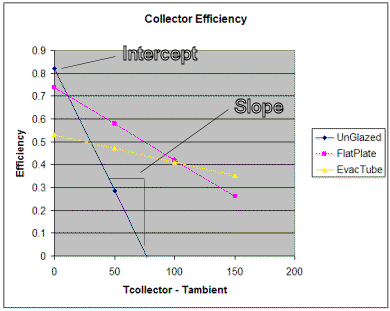The Calculator Inputs:
These are the numbers you need to enter to get an efficiency calculation:

Intercept -- This is efficiency value where the efficiency
curve cross the vertical axis -- that is, when there is no difference
between the collector temperature and ambient temperature.
Slope -- This is the downward slope of the efficiency
curve. It is the rate of drop in efficiency as outside temperature and
solar radiation drop.
These two parameters define the efficiency curve for
the collector. You can get these from the SRCC certification report
for each collector.
I have also provided these values for several common example collectors of each
type in the calculator. Just click on the one you want.
For more information on the efficiency curve, what it
depends on, and how its determined, look
here...
Ambient air temperature -- This is just the temperature
of the air around the collector -- i.e. the outside air temperature.
Collector Temperature -- This is the average temperature
of the fluid going through the collector. This would ideally be the
average of the collector inlet and outlet temperatures, but a good
approximation would be to use what you believe the storage tank temperature
will be plus about 5F. You might want to do the calculation for
several storage tank temperatures, and see what the effect is on efficiency.
The difference between the collector temperature and the ambient temperature
is a major factor in determining the heat lost from the collector to the
outside, and therefore the efficiency of the collector.
Solar Intensity -- This is the intensity of the solar
radiation striking the collector measured in BTU per square foot of
collector area per hour.
A typical sunny day value with the collector pointed at the sun would
be about 300 BTU/ft^2-hr. Cloudy weather values vary
considerably, but the SRCC uses about 75% of the full sun value for "Mildly
Cloudy", and about 50% of the full sun value for "Cloudy Day".
During the early morning and late afternoon, the solar intensity that the
collector sees is less, because of the angle that the sun makes with the
collector face. For example, if the sun makes a 45 degree angle with
the collector face, the effective solar intensity is cut by 30% from the
full sun value.
The Calculator Outputs:
After filling in the inputs, click the "Calculate" button, and calculator
will calculate the two output values.
Efficiency -- The efficiency of the collector.
That is, (Collector Heat Output / Total Solar Input). The efficiency
is calculated for the specific conditions you entered. You will find
that the efficiency varies greatly for different conditions. The idea
of the calculator is to give a feel for how the efficiency and output vary
as the collector and the system design are changed.
Output -- This is the heat output of the collector per
square foot of collector area per hour. This is the the output for the
specific conditions you entered.
Note that this is not at all rocket science -- the actual calculation of
efficiency is one very short line -- this calculator is 99% fluff and 1%
calculation. But, I feel that a lot of people struggle with deciding
which collector is going to do best under a particular set of circumstances,
and what effect a change in the system design might have on efficiency.
My hope is that this calculator helps a little in making a good decision.
Please
read this...If you have any comments,
corrections, or suggestions on the calculator, please
email me:
Gary

